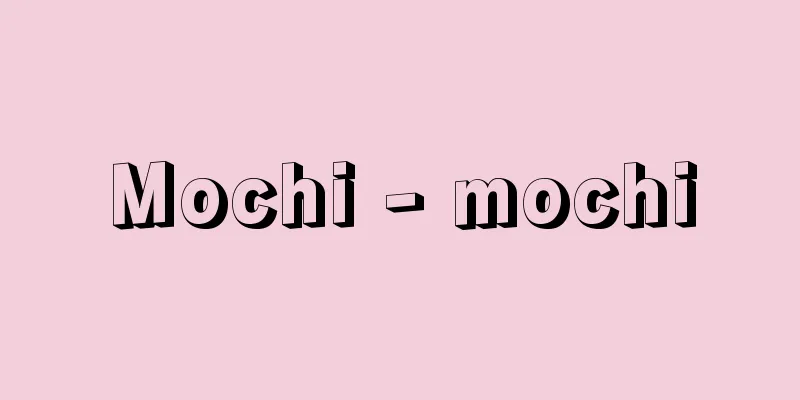Mochi - mochi

|
It usually refers to glutinous rice that is steamed, pounded, and shaped, but it also refers to other grains such as rice (non-glutinous) and foxtail millet, and to those made from kneaded rice flour and starch such as kudzu starch. There are several theories about the origin of the word, including that it comes from mochiii (sticky rice), mochiii (rice that can be carried and stored), and even mochi, which means full moon, but there is no consensus. The culture of mochi was introduced from Southeast Asia along with rice-growing culture, and there are commonalities in the shapes, varieties, and folk customs of different regions. In Japan, people have a particular preference for the stickiness of mochi, which is what has created a unique mochi culture. In the Shosoin documents, foods with the name mochi, such as soybean mochi (mame mochi), red bean mochi (azuki mochi), rice cracker mochi (iri mochi), and ring mochi (magari mochi), can be seen. In the Nara period, mochi seems to have been used as a confectionery for the nobility. In the Heian period, various ceremonial foods were established, such as kagami mochi and mochigayu (mochi rice porridge) in January, kusa mochi (kusa mochi) in March, and chimaki and kashiwa mochi (oak leaf mochi) in May. In this period, in addition to pounded mochi, which is made by pounding steamed rice grains, mochi with various ingredients added and mochi made from flour can be seen. In the Kamakura period, mochi sweets such as bota mochi, yaki mochi, and chimaki became common. During the Edo period, mochi became increasingly common, with mochi sweets being used at annual events and specialty mochi being sold along the highways of various provinces. [Tomomi Kono and Yonago Yamaguchi] kindsIn terms of ingredients, in addition to those made only from rice, there are those made with other ingredients such as millet mochi, tochi mochi, bean mochi, millet mochi, kanba mochi (mixed with sweet potato flour), and kusa mochi, as well as rice-free varieties such as kudzu mochi and warabi mochi. In terms of use, they can be divided into staple foods, ceremonial uses (kagami mochi, tsurunoko mochi, hishi mochi, chimaki, kashiwa mochi, inoko mochi, etc.), and sweets (various types of mochi sweets such as daifuku mochi). In terms of shape, there are round mochi, noshi mochi, namako mochi, and more recently, vacuum-packed packaged mochi. Processed and preserved mochi includes hoshi mochi, kori mochi (freeze-dried), mizu mochi, as well as kaki mochi and senbei rice crackers. In terms of how it is made, pounded mochi, in which steamed glutinous rice is pounded whole grain, is the most common, but there are also other varieties such as steamed mochi, in which rice flour is kneaded with hot or cold water, shaped, and then steamed, as well as mochi made by roughly pounding cooked rice (such as gohei mochi and botamochi). [Tomomi Kono and Yonago Yamaguchi] Foreign rice cakesIn Japan, the character mochi is used, but in China, mochi (bing) is a general term for wheat products such as mantou (buns) and gyoza (dumplings), with a focus on baked sweets made from wheat flour. The equivalent of pounded mochi, made from steamed glutinous rice, is found in Yunnan, Hunan, and Sichuan provinces in China, and is called tsu (tsu) or tsu (tsu). The most common mochi-like food in China is called kao (gao), which is made by kneading and steaming flour from grains other than wheat, such as rice, foxtail millet, beans, and millet. Mochi in the Korean peninsula is called ttǒk, and there are more than 40 kinds. There are also many different ways to make them, and they can be broadly categorized into steamed mochi, pounded mochi, fried mochi, and dumplings. Compared to China and the Korean peninsula, mochi in Japan is dominated by pounded mochi, which is made by pounding steamed rice grains. This pounded mochi has also been confirmed in Taiwan, the Indochina peninsula, Myanmar (Burma), and other places, but it is especially popular in Japan. [Tomomi Kono and Yonago Yamaguchi] keepMochi contains about 45% moisture when pounded. Therefore, if left in this state, it has no shelf life and is prone to mold. Mold is particularly likely to form on the flour on the surface. To preserve it at home, remove the flour and store in the refrigerator for short periods and in the freezer for long periods. Any mold that grows can be scraped off with a knife, but care must be taken as the flavor will be lost and one type of blue mold can produce carcinogenic substances such as aflatoxin. [Tomomi Kono and Yonago Yamaguchi] nutritionLike rice, mochi is mainly composed of carbohydrates and serves as an energy source. It is digested and absorbed at the same rate as cooked rice, but it stays in the stomach for a slightly longer time. The reason mochi keeps you full for so long is probably because you eat too much of it, rather than because it stays in the stomach for so long. Because mochi is small in volume, it is much higher in energy than cooked rice for the same volume. It is said that if you eat grated daikon radish at the same time, like with oroshi mochi, the amylase in the daikon radish will aid digestion. [Tomomi Kono and Yonago Yamaguchi] cookingOne dish made with mochi is the New Year's dish Zōni, with each region having its own distinctive shape (cut mochi, round mochi), seasoning (miso-based, clarified), and ingredients. Other dishes made with mochi include grilled mochi and Abekawa mochi, and it is also used in soups, noodles, and hotpot dishes. Each region has a variety of local dishes, many of which are linked to folk customs. [Tomomi Kono and Yonago Yamaguchi] FolkloreJapanGenerally, mochi is used for celebrations such as New Year's Day, seasonal festivals, the birth of a child, weddings, and the construction of a new house, but in addition to these occasions, there are also mochi used in the event of misfortune. One such mochi is called mimi fusagi mochi, and when a person hears of the death of someone in the same year, they pound a mochi and use it to cover their ears, hence the name. It seems that mochi was believed to have some kind of mystical power. In the Bungo no Kuni Fudoki, there is a legend about a man who shot a mochi at a target, but it turned into a swan and flew away, causing the downfall of a wealthy man, and people in ancient times considered mochi to be spiritual. In the mid-modern period, chikara mochi began to be sold as a specialty at teahouses on mountain passes, and it is likely that the reason it became so popular was because there was a belief that eating this mochi would give you strength. In parts of Niigata Prefecture, mochi balls used as decorations for Little New Year, placed in azuki bean porridge, are called Chikara-mochi, and it is said that eating them will give you strength. In parts of Saga Prefecture, there is a superstition that eating Chikara-mochi on the 20th of the New Year will keep you from getting sick. In some areas, Chikara-mochi is also used to refer to mochi given to women who are physically weak after giving birth, or mochi that is carried or held by children one year after birth. On Koshikijima Island in Kagoshima Prefecture, it is said that on the night of New Year's Eve, a white-bearded old man called Toshi-don visits each house on a headless horse, ringing a bell, and distributes rice cakes as New Year's gifts to children. On the night of New Year's Eve on Hachijojima, a shelf is hung to worship the New Year God, and mochi is offered on the shelf for each member of the family. These mochi are called miwai-no-mochi, and have a single mochi ball the size of a plum attached to the top. The mochi ball is called tamashii, and when the family members eat the mochi soup that is brought from the shelf on the fourth day of the New Year, they always eat one tamashii each. Both of these customs can be said to recognize the spiritual power of mochi. [Mikiharu Ito] KoreaLike Japan, Korea has many kinds of mochi. The Dongguk Saijiki (1849), which explains annual events, describes various ways of making mochi, such as steamed mochi, hikki mochi, white mochi, steamed mochi, matsu mochi, and ring mochi. Steamed mochi is made by pounding glutinous rice flour thoroughly, tearing off pieces one by one, fermenting them in sake, forming them into the shape of a bell, filling them with bean paste, placing jujube nuts on top, and steaming them. Hikki mochi is made by steaming and pounding glutinous rice flour, sprinkling it with boiled beans or sesame seeds. White mochi is made by steaming non-sticky rice flour, placing it on a large board, pounding it, and stretching it out into a long shape. Steamed mochi is made by placing glutinous rice or non-sticky rice flour in a steamer, placing boiled red beans on top, and steaming the flour and red beans in alternating layers. Matsumochi is a type of white rice cake in a half-moon shape, small and large, filled with bean paste, separated by pine needles, steamed, washed with water, and coated with fragrant oil. Ringmochi is a type of rice cake filled with the soft flesh of the pine tree and mugwort from under the bark of the pine tree, and then colored. These rice cakes are made on the folds of the New Year and Chuseok (the 15th day of the 8th month of the lunar calendar). [Mikiharu Ito] ChinaAmong the Han people, they make and eat year cakes (nian kao) on New Year's Day. They are made from glutinous rice and seasoned with sugar, and some are sprinkled with boiled jujubes. On Mid-Autumn Festival (the 15th day of the 8th month of the lunar calendar), there is a custom of making mooncakes (geppei), which are round baked cakes made from kneaded wheat flour and stuffed with bean paste. Ethnic minorities living in the southwestern part of China prefer foods made from glutinous rice, and the Buyi people, a Zhuang ethnic group living in the southern part of Guizhou Province, eat glutinous rice that is steamed, pounded with a pestle, and shaped into flat circles with red beans or sesame seeds inside, or glutinous rice that is roasted and rolled into balls with brown sugar. The Dong people, a Dai ethnic group living in the southeastern part of Guizhou Province, also make round rice cakes for New Year's Day. [Mikiharu Ito] "Watanabe Tadayo and Fukazawa Sayuri, 'Cultural History of Things and Humans 89: Mochi (Glutinous Rice Cake)' (1998, Hosei University Press)" ▽ "Amuro Satoru, 'Mochi and the Japanese: A Folk Cultural Theory of 'Mochi New Year' and 'Mochi-less New Year' (1999, Yuzankaku Publishing)" ▽ "Sakamoto Yasuo, 'Cultural History of Mochi: Japanese Eating Habits on Special Occasions' (Chuko Shinsho)" [Reference] |They are offered to the god of the year, the god of the year, during the New Year. It is said that stacking rice cakes is auspicious because it brings about overlapping good fortune. They are decorated with daidai (citrus fruit), kelp, and urajiro (white seaweed), and are decorated with fans, paper streamers, and mizuhiki (traditional Japanese paper string). The number of stacked rice cakes and the decorations used vary. ©Shogakukan "> Kagami mochi In addition to those made from glutinous rice and millet, there are also those made from glutinous rice and millet . Millet rice cake ©Shogakukan "> Kakimochi ©Shogakukan "> Walnut mochi Also known as frozen rice cake ©Shogakukan "> Frozen rice cake ©Shogakukan "> Sesame mochi ©Shogakukan "> Shiso mochi ©Shogakukan "> Horse chestnut mochi ©Shogakukan "> Bean cake Kirimochi is made by mixing steamed glutinous rice and mugwort ©Shogakukan "> Mugwort rice cake Mochi pounding in the Edo period. This painting shows mochi being pounded with a mortar and pestle (photo right) and then turned into kagami mochi (kagami mochi) from the pounded mochi (photo left). Mochi pounding was one of the preparations for the New Year and was a seasonal event at the end of the year in Edo. Utagawa Kunisada (Toyokuni III) painting "Twelve Months, Shiwasu, Mochi Pounding" Triptych 1854 (Kaei 7) National Diet Library Mochi pounding Source: Shogakukan Encyclopedia Nipponica About Encyclopedia Nipponica Information | Legend |
|
通常は、糯米(もちごめ)を蒸し、搗(つ)きつぶして成形したものをいうが、米(粳(うるち))、アワなど、他の穀物を用いたもの、米粉をこねてつくるもの、葛(くず)粉などデンプンでつくるものも広く餅とよぶ。語源については糯飯(もちいい)(黐飯(もちいい)、粘りのある飯)、持飯(もちいい)(持ち運び、保存可能な飯)、さらに、望月(もちづき)という意味の望(もち)であるなどの説があるが定説はない。 餅の文化は稲作文化とともに東南アジアから伝わったもので、形態、種類、民俗などに各地の共通点がみられる。日本ではとくに、餅の粘りに対する特有の嗜好(しこう)をもち、そのために特有の餅文化をつくりあげたといえる。「正倉院文書」には大豆餅(まめもち)、小豆餅(あずきもち)、煎餅(いりもち)、環餅(まがりもち)など餅という名のついた食品がみられる。奈良時代には餅は貴族の菓子として用いられたようである。平安時代になると各種の行事食が確立し、1月の鏡餅や餅粥(もちがゆ)、3月の草餅、5月のちまきや柏餅(かしわもち)などもみられる。この時代には米粒を蒸して搗く搗き餅のほかに、各種の材料を加えた餅、粉類を用いる餅がみられる。鎌倉時代にはぼた餅、焼き餅、ちまきなどの餅菓子が一般化した。江戸時代には餅がますます一般化し、年中行事には餅菓子が使われ、諸国の街道筋で名物餅が売られた。 [河野友美・山口米子] 種類材料からは、米だけでつくったもの以外に、他の材料を加えた粟(あわ)餅、栃(とち)餅、豆餅、黍(きび)餅、かんば餅(サツマイモの粉を混ぜたもの)、草餅などが、また、米を使わない葛餅、わらび餅などもある。用途からは主食用、儀式用(鏡餅、鶴(つる)の子餅、菱(ひし)餅、ちまき、柏餅、亥の子(いのこ)餅など)、菓子用(大福餅など各種の餅菓子)に分けられる。また、形からは丸餅、のし餅、なまこ餅、最近のものとして真空包装された包装餅がある。餅の加工保存品には干餅(ほしもち)、凍り餅(冷凍乾燥したもの)、水餅、そのほか、かき餅、煎餅(せんべい)などがある。作り方では、蒸した糯米を粒ごと搗く搗き餅が主流で、米粉を湯や水でこね、成形してから蒸す蒸し餅の系統や、炊き上げたご飯を粗つぶしにするもの(御幣(ごへい)餅、ぼた餅など)などがある。 [河野友美・山口米子] 外国の餅日本では餅という字を用いるが、中国での餅(ピン)は小麦粉を用いた焼き菓子を中心に、饅頭(マントウ)、餃子(ギョウザ)などの小麦製品の総称である。蒸した糯米を用いる搗き餅にあたるものは中国の雲南、湖南、四川(しせん)省などに点在し、これは糍(ツー)または餈(ツー)とよばれる。中国でもっとも一般的な餅状の食品は糕(カオ)といい、米、アワ、豆、キビなど小麦以外の穀粉を用いてこねて蒸したものである。 朝鮮半島での餅はトクttǒkとよばれ、40種以上もの種類がある。作り方も多様で、蒸し餅、搗き餅、油焼き餅、団子類に大別される。中国や朝鮮半島に比べ、日本では餅といえば蒸した米粒を搗く搗き餅が中心である。この搗き餅は台湾、インドシナ半島、ミャンマー(ビルマ)などでも確認されているが、とくに日本で嗜好されている。 [河野友美・山口米子] 保存餅は搗き上げた状態で水分を約45%含む。そのため、このままでは保存性がなく、カビがつきやすい。とくに表面についているとり粉にカビが生じやすい。家庭内での保存法としては、とり粉を落として短期には冷蔵庫、長期には冷凍庫に入れる。多少のカビは包丁で削り落とせばよいが、風味が落ち、アオカビの一種は発癌(がん)性のあるアフラトキシンといった物質を生産するので注意を要する。 [河野友美・山口米子] 栄養米と同様、糖質が主成分でエネルギー源となる。消化吸収率はご飯と同様であるが、胃内での停滞時間がやや長い。餅は腹もちがよいというのは、むしろ胃内停滞時間よりも食べすぎるためと考えられる。餅はかさが小さいため、米飯よりも同体積で比べると非常に高エネルギーである。おろし餅のように大根おろしを同時に食べると大根のアミラーゼが消化を助けるといわれる。 [河野友美・山口米子] 料理餅の料理としては正月の雑煮(ぞうに)があり、各地で餅の形(切り餅、丸餅)、調味法(みそ仕立て、澄まし仕立て)、具に特徴がある。ほかの料理としては焼き餅、安倍川(あべかわ)餅、そのほか汁物、麺(めん)類、鍋(なべ)物などにも用いられる。各地にいろいろな郷土料理があり、民俗と結び付いたものも多い。 [河野友美・山口米子] 民俗日本一般に、餅は正月や節供、子供の誕生、婚礼、家の新築などの祝い事に用いられるが、こうした機会のほかに、凶事の際に用いられる餅もある。耳塞(みみふさ)ぎ餅というのがそれで、同年の者の死を聞くと、餅を搗き、その餅で耳を塞ぐので、耳塞ぎ餅とよばれている。餅にはなにか神秘的な力が宿っていると信じられていたらしい。『豊後国風土記(ぶんごのくにふどき)』に、餅を的にして射たところ、その餅が白鳥となって飛び去り、長者が没落したという伝説があるが、古代の人々は餅を霊的なものと考えていた。近世中期に、峠の茶屋などの名物として力餅が売られるようになるが、力餅が普及するようになったのも、この餅を食べると力がつくという信仰があったからであろう。新潟県の一部では、小(こ)正月の飾りにした餅団子を小豆粥(あずきがゆ)に入れたものを力餅といい、これを食べると力が出ると伝えられている。佐賀県の一部には、正月20日に力餅を食べると病気にならないという俗信がある。また、産後、身体の弱った女性に食べさせる餅や、生まれてから1年たった子供に背負わせたり抱えさせたりする餅を力餅とよぶ土地もある。鹿児島県の甑島(こしきじま)では、大晦日(おおみそか)の夜、年どんといって白いひげを生やした老人が、首のない馬に乗って鈴を鳴らしながら各戸を訪れ、子供たちに年玉の餅を配ると伝えられている。八丈島では、大晦日の夜、年神(としがみ)を祀(まつ)る棚を吊(つ)り、その棚に餅を家族の人数だけ供えるが、この餅は身祝いの餅とよばれ、その上に梅の実ぐらいの大きさの餅の玉が一つつけてある。その餅の玉はタマシイとよばれ、家の者は正月4日に棚下ろしの雑煮を食べるとき、かならずタマシイを一つずつ食べるという。いずれも餅に霊的な力を認めた慣習といってよいだろう。 [伊藤幹治] 朝鮮日本と同じように、朝鮮にもいろいろな種類の餅がある。年中行事を解説した『東国歳時記』(1849)に、蒸餅や引餅、白餅、甑餅、松餅、環餅など、餅の製法がいろいろ述べられている。蒸餅は糯米の粉をよく搗いて一片ずつちぎり取り、酒で発酵させて鈴の形のようにし、これに餡(あん)を入れて、上にナツメの実をはめ込んで蒸した餅。引餅は糯米の粉を蒸して搗き、これに煮豆やゴマをふりかけた餅。白餅は粳の粉を蒸して大きな板の上に置き、これを搗いて長く引き伸ばした餅のことである。また、甑餅は糯米または粳の粉を甑の中に敷き、その上に煮た小豆を敷いて、粉と小豆を交互に積み重ねて蒸した餅。松餅は半月形の大小の白餅に豆の餡を入れ、これを松葉で隔てて蒸し、水で洗ってから香油を塗った餅。環餅は松の表皮の下の柔らかな肉皮やヨモギを入れ、それに色づけした餅のことである。これらの餅は、正月や秋夕(しゅうせき)の節(旧暦8月15日)などの折り目につくられる。 [伊藤幹治] 中国漢民族の間では、正月に年糕(ニェンカオ)をつくって食べる。これは、糯米を材料にして砂糖で味つけしたもので、表面に煮たナツメの実をまぶしたものもある。仲秋節(ちゅうしゅうせつ)(旧暦8月15日)には、小麦粉をこねて中に餡などを入れて丸く焼いた月餅(げっぺい)をこしらえる習慣がある。西南部に住む少数民族は糯米を材料にした食物を好み、貴州(きしゅう/コイチョウ)省の南部に住むチワン系民族のプイ族は、正月に糯米を蒸して杵(きね)で搗き、これを平たい円形にして、その中に小豆やゴマを入れた餅とか、糯米を炒(い)って黒砂糖で丸くしたものを食べる。同じ貴州省の南東部に住むタイ系民族のトン族も、正月になると丸い餅をつくる。 [伊藤幹治] 『渡部忠世・深沢小百合著『ものと人間の文化史89 もち(糯・餅)』(1998・法政大学出版局)』▽『安室知著『餅と日本人――「餅正月」と「餅なし正月」の民俗文化論』(1999・雄山閣出版)』▽『阪本寧男著『モチの文化誌――日本人のハレの食生活』(中公新書)』 [参照項目] |正月に迎える歳神(年神)に供える。重ね餅にするのは福徳が重なり縁起がよいためといわれている。ダイダイ、昆布、ウラジロなどを添え、扇や紙垂、水引などを飾る。重ねる餅の数や用いる飾りはさまざまである©Shogakukan"> 鏡餅 糯種のアワだけで搗いたもののほか、糯米に糯アワを加えて搗いたものがある©Shogakukan"> 粟餅 ©Shogakukan"> かき餅 ©Shogakukan"> くるみ餅 凍み餅ともいう©Shogakukan"> 凍り餅 ©Shogakukan"> ごま餅 ©Shogakukan"> しそ餅 ©Shogakukan"> 栃餅 ©Shogakukan"> 豆餅 蒸した糯米とヨモギを搗き混ぜてつくられた切り餅©Shogakukan"> よもぎ餅 江戸時代の餅搗き。臼と杵で餅を搗き(写真右)、搗きあがった餅で鏡餅をつくっている(同左)ようすが描かれている。餅搗きは正月の準備の一つとして、江戸の年末の風物詩であった。歌川国貞(3世豊国)画『十二月之内 師走 餅つき』 三枚続 1854年(嘉永7)国立国会図書館所蔵"> 餅搗き 出典 小学館 日本大百科全書(ニッポニカ)日本大百科全書(ニッポニカ)について 情報 | 凡例 |
<<: Mochigase [town] - Mochigase
Recommend
Woolworth, FW (English spelling) WoolworthFW
…Headquarters: New York. Woolworth was founded in...
Donation of Constantine - Donatio Constantini
This document is said to be the greatest forgery o...
Kurobane [town] - Kurobane
A former town in Nasu County, northeastern Tochigi...
Aichichi - Aichichi
...The first breast milk is called arachichi (new...
Spinner dolphin (long-beaked dolphin)
A mammal of the family Delphinidae in the suborder...
Asakusa Enshu-ryu
...One of the schools of tea ceremony founded by ...
Tochikagami - Tochikagami
A floating perennial plant of the family Hormonac...
Horse Zhan Mountain
A Republic of China soldier. His pen name was Xiu...
Omura
… [Katsumi Matsushita] [cooking] As Kaibara Ekike...
Odigitria
...Icons that performed miracles were spoken of, ...
International'noe bratstvo (English spelling)
...After his sentence was commuted, he planned to...
Economic policy
Today, every country in the world is faced with t...
Plane - Kanna
〘Noun〙 (A variation of "kana (plane)") A...
articulation reference equivalent
...As shown in the table, evaluation scales such ...
"Kanpei Gyoki" - Kanpyo Gyoki
…Diary of Emperor Uda during his reign. Also call...





![Suleiman [I] - Suleiman](/upload/images/67cbfba18998a.webp)



